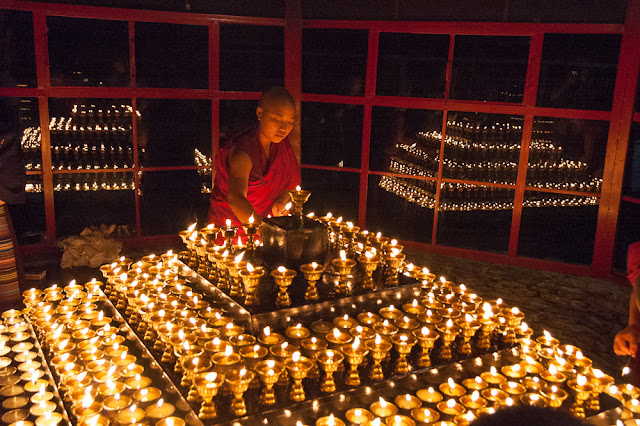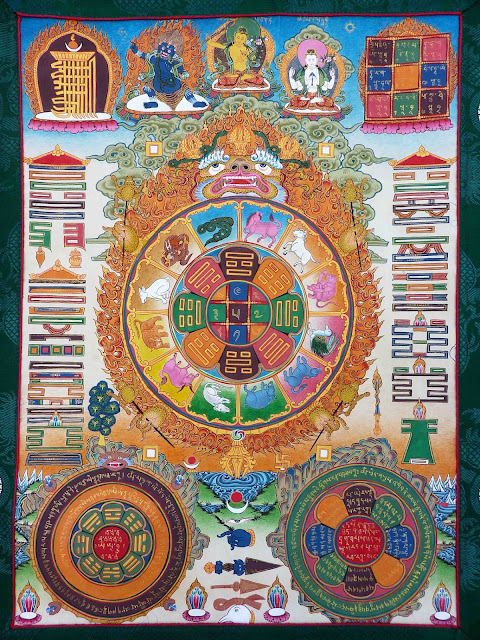Every drop of water helps to swell the ocean
Every good and bad action will not go unnoticed
Do you earnestly cherish our devoted work? Assuming this is the case, would you consider making a donation for our Buddhist research and development. We need you to help secure the future of scholarly interaction with Buddhism.
Your generosity will certainly help us improve our works and to achieve for a better and brighter prospect to come.
Praises to the Lord Dzambhala
The one who controls the harm-givers, whose holy body is elegant in nine ways of acting, who is well-tied with rainbow aggregates made of melted white crystal, who grants wish-giving realizations like a rainfall. I pray homage and prostrate to the glorious Guru White Dzambhala.
Three offerings to the White Dzambhala 白財神
One could offer spheric dessert made from three “white"offerings, such as milk, yoghurt, flour and three “sweet " of white sugar, rock sugar, honey to White Dzambhala.
White Dzambhala he is God of Wealth. He will fulfill your wishes, make you connect with spiritual and worldly wealth and create financial stability and prosperity if worshiped with a pure and proper motivation, Bodhichitta and compassion toward other beings.
In Tibetan language he is known as " Dzambhala Gapee" he is the compassionate manifestation of the Bodhisattva Chenrezig (Guan Yin). He can remove the suffering of poverty and sickness, purify non-virtuous karma and karmic obstacles, avert disaster and sickness, and evolve bodhicitta mind.
As the manifestation of Avalokitesvara Bodhisattva, White Dzambhala was born from his right eye. White Dzambhala is depicted sitting on a dragon, and a mongoose in his left hand spits out precious diamonds and ornaments. White Dzambhala has white colored body. He also holding a Wealth Banner in his left arm and a gold sword in his right.
All the five Dzambhalas are the protector of all Lineages and of all sentient beings from all sickness and difficulties. White Dzambhala is manifested in a wrathful form with a significant purpose:-
”Because in this world, there are all kinds of wrathful and negative emotions or bad spirits, and sometimes they will harm you and other sentient beings, Dzambhala must take on such a wrathful and powerful form to protect us from these harmful spirits and negative karma.
Especially, Dzambhala helps us minimize or decrease all misfortunes and obstacles and helps us increase all good fortune and happiness. Especially, Dzambhala helps us minimize or decrease all misfortunes and obstacles and helps us increase all good fortune and happiness.
There are five different colors manifestation of wealth Zambhala, the Yellow, Red, Green, White and the Black.
Each has their own practice and mantra to help eliminate poverty and create financial stability, The five Zambhalas wealth deities are to guide sentient beings along the path to enlightenment. They have the essence of generosity and represent the activities of increasing benefit. Their aspirations are to help the poor and those suffering from ill-fortune.
Pouring water on a statue of White Dzambhala.
If you have a statue of Dzambhala you pour water on his head, for added blessings.
Legend has it, when Buddha Sakyamuni was teaching Maha Prajna-Paramita Sutra , Devadatta is overwhelmed envy hurled stones to Buddha . However, the stone hit the head Zambhala White and Yellow and Black Dzambhala stomach.
The Buddha then went and to and blessed all the Dzambhalas; flowing substance of his wisdom, compassion, and love is white, like nectar, and touching the head Dzambhala. Dzambhala feel very happy, joyful, peaceful, and free from defilement and restrictions, as well as to heal.
Dzambhala immediately bowed to the Buddha and grateful. Buddha Sakyamuni said to him, "As I am already healed you and myself had poured the nectar of this holy unto you, in the future, if one of my students who invoke strength and pour water over your head - bless them with wealth, give them two types wealth, material wealth and spiritual wealth, especially the more important is the spiritual wealth.
Dzambhala replied to the Lord Buddha and pressed his palms and said," I will do as your word and I promised that I would.
Thank you for reading, may you find peace and great bliss. With your support it helps to spread the Buddha’s precious teachings and turning the Dharma wheels in the world.
Aspiration For Bodhichitta
For those in whom the precious Bodhichitta has not arisen
May it arise and not decrease
But increase further and further.
Dedication of Merit
By this merit may we obtain omniscience then.
Having defeated the enemies wrong-doings.
May we liberate migrators from the ocean of existence.
With its stormy waves of birth, old age, sickness and death.
Note
I do not own or violated any infringement copyright of these pictures, Pictures courtesy and credit to the rightful owners.






































